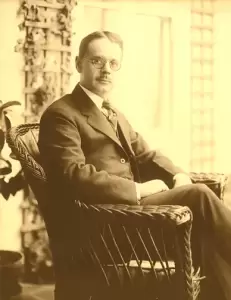Growth: What Did $2.5 Million Buy in 1919?

On his first visit to Palm Beach County in 1919, Boston entrepreneur Harry Seymour Kelsey (1879–1957) joined the Florida land boom by buying 30,000 acres north of West Palm Beach. Kelsey then sold his interest in the Waldorf restaurant chain he had created for $3 million, set up the East Coast Finance Corporation, and soon owned more real estate than anyone else in Palm Beach County.
Kelsey purchased about 100,000 acres over 17 miles between Jupiter and Riviera, including what is now Lake Park, most of North Palm Beach, the Seminole Golf Club, and much of Palm Beach Gardens. In putting together contiguous parcels over several months, Kelsey bought from over 60 owners, including the Model Land Company, the James M. Munyon Estate, the Southern States Land and Timber Company, and many individuals. He paid from $6 per acre inland to $350 per acre for lakefront and $100 per front foot for oceanfront, a total of about $2.5 million.
In 1920 Harry Kelsey announced his plans for his holdings, which ranged from an upscale resort to farms of all kinds to a planned community with varied land uses.
A golf resort on Munyon Island was to be called Palm Beach Harbour, featuring a 12-story hotel; it was never developed. A brochure described the proposed development:
The island, on which the hotel will be situated, will be approached from the mainland over bridges; a causeway will connect the island with the oceanfront. Real gondoliers will sail upon the blue waters of the lake, and electric lights will brighten the trees and foliage. Smaller islands adjacent to the hotel will be connected by Japanese bridges.
Kelsey had an established dairy in the North and listed many agricultural industries in his plans for Kelsey City: sugar cane farms, demonstration and stock raising farms, hog and poultry farms, citrus groves, truck and dairy farms. Kelsey Model Dairy Farm, south of the Earman River between today’s Alt. A1A and Prosperity Farms Road, was established by 1925 and one of the first dairies to offer delivery in Palm Beach County.
Kelsey chose the scrub ridge for the townsite of Kelsey City, later renamed Lake Park. Noah Kellum Williams, Harry Kelsey’s chief engineer and construction superintendent, wrote that his first assignment was to create a “Negro Quarters” southwest of Kelsey City, to relocate several small houses from within the new town’s borders. Williams reported that he sold them easily to African Americans at fair prices and terms.

